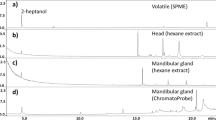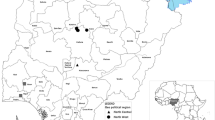Abstract
In highly social hymenopteran societies, males mainly serve reproductive purposes. Semiochemicals enable the different hymenopteran sexes and castes to communicate with each other and to coordinate important functions within colonies. I hereby show that sexual dimorphism in meliponine bees incorporates the alarm and defence communication system. I chemically analysed the mandibular glands of Scaptotrigona aff. depilis using GCMS methods and conducted behavioural experiments in both males and female workers using cephalic and mandibular gland extracts. In addition, behaviour studies with male cephalic extracts were also conducted in Scaptotrigona bipunctata and Partamona cupira. Males and female worker bees showed differences in the content of the mandibular glands, which are responsible for alarm communication in meliponines. Males never attacked but usually fled when confronted with the mandibular gland extract content of other conspecific males or females. Interestingly, however, meliponine males were still able to raise alarm and to induce substantial amounts of aggression at nest entrances, which is different from the much better known and studied honey bees. Potential reasons are briefly discussed.




Similar content being viewed by others
References
Alcock J (1981) Lek territoriality in the tarantula hawk wasp Hemipepsis ustulata (Hymenoptera: Pompilidae). Behav Ecol Sociobiol 8:309–317
Alcock J, Barrows EN, Gordh G, Hubbard J, Kirkendall L, Pyle DW, Ponder TL, Zalom FG (1978) The ecology and evolution of male reproductive behaviour in the bees and wasps. Zool J Linn Soc 64:293–326
Bagnères A, Hanus R (2015) Communication and social regulation in termites. In: Aquiloni L, Tricarioco E (eds) Social recognition in invertebrates: the knowns and the unknowns. Springer, Cham, pp 193–248
Becker MM, Brückner D, Crewe R (2000) Behavioural response of drone honey bees, Apis mellifera and Apis mellifera scutellata, to worker-produced pheromone components. J Apic Res 39:149–152
Bento MJS, Della Lucia TMC, Do Nascimento RR, Bergmann J, Morgan ED (2007) Response of workers of Atta sexdens rubropilosa (Hymenoptera: Formicidae) to mandibular gland compounds of virgin males and females. Physiol Entomol 32:283–286
Blum MS (1966) Chemical releasers of social behavior. VIII. Citral in the mandibular gland secretion of Lestrimelitta limao (Hymenoptera: Apoidea: Melittidae). Ann Entomol Soc Am 59:962–964
Blum MS, Brand JM (1972) Social insect pheromones: their chemistry and function. Am Zool 12:553–576
Blum MS, Padovani F, Amante E (1968) Alkanones and terpenes in the mandibular glands of Atta species. Comput Biochem Physiol 26:291–299
Boch R, Shearer DA, Stone BC (1962) Identification of iso-amyl acetate as an active component in the sting pheromone of the honey bee. Nature 195:1018–1020
Boomsma JJ, Baer B, Heinze J (2005) The evolution of male traits in social insects. Annu Rev Entomol 50:395–420
Bourke AF (2011) The validity and value of inclusive fitness theory. Proc R Soc B 278:3313–3320
Brough EJ (1983) The antimicrobial activity of the mandibular gland secretion of a formicine ant, Calomyrmex sp. (Hymenoptera: Formicidae). J Invertebr Pathol 42:306–311
Camargo JMF, Pedro SRM (1992) Systematics, phylogeny and biogeography of the Meliponinae (Hymenoptera, Apinae): a mini-review. Apidologie 23:509–522
Camargo JMF, Pedro SRM (2007) Meliponini Lepeletier, 1836. In: Moure JS, Urban D, Melo GAR (eds) Catalogue of bees (Hymenoptera, Apoidea) in the neotropical region. Sociedade Brasileira de Entomologia, Curitiba
Cameron EC, Franck P, Oldroyd BP (2004) Genetic structure of nest aggregations and drone congregations of the Southeast Asian stingless bee Trigona collina. Mol Ecol 13:2357–2364
Clutton-Brock TH, Price OF, Maccou ADC (1991) Mate retention, harassment, and the evolution of ungulate leks. Behav Ecol 3:234–242
Colle LK, Blum M, Roncadori RW (1975) Antifungal properties of the insect alarm pheromones, citral, 2-heptanone and 4-methyl-3-heptanone. Mycologia 67:701–708
Cruz-López L, Aguilar S, Malo EA, Rincón M, Guzman M, Rojas JC (2007) Electroantennogram and behavioural responses of workers of the stingless bee Oxytrigona mediorufa to mandibular gland volatiles. Entomol Expert Appl 123:43–47
da Cruz-Landim C (1967) Estudo comparativo de algumas glândulas das abelhas (Hymenoptera, Apoidea) e respectivas implicações evolutivas. Arq Zool 15:177–290
da Cruz-Landim C, Abdalla FC (2002) Glândulas exócrinas das abelhas. Funpec, Ribeirão Preto
Eisner T, Eisner M, Siegler M (2005) Secret weapons. Belknap Press, London
Engels E, Engels W (1984) Drohnen-Ansammlungen bei Nestern der Stachellosen Biene Scaptrotrigona postica. Apidologie 15:15–328
Engels E, Engels W, Lübke G, Schröder W, Francke W (1990) Volatile secretions of drones, queens and workers in relation to reproduction in the stingless bee, Scaptotrigona postica (Hymenopterea: Apidae, Trigonini). Entomol Generalista 15:91–101
Feener DH Jr, Jacobs LF, Schmidt JO (1996) Specialized parasitoid attracted to a pheromone of ants. Anim Behav 51:61–66
Fierro MM, Cruz-López L, Sánchez D, Villanueva-Guitiérrez R, Vandame R (2011) Queen volatiles as a modulator of Tetragonisca angustula drone behavior. J Chem Ecol 37:1255–1262
Francke WG, Lübke G, Schröder W, Reckziegel A, Imperatriz-Fonseca V, Kleinert A, Engels E, Hartfelder K, Radtke R, Engels W (2000) Identification of oxygen containing volatiles in cephalic secretions of workers of Brazilian stingless bees. J Braz Chem Soc 11:562–571
Free JB (1987) Pheromones of social bees. Cornell University Press, New York
Giannotti E, Pinto NPO (2001) Predação de machos de Trigona (Scaptotrigona) postica Latreille (Hymenoptera, Apidae, Meliponinae) por Trachypus boharti Rubio (Hymenoptera, Sphecidae, Philanthinae). In: Prezoto F (ed) Anais do XIX Congresso Brasileiro de Etologia, 1–4 novembro. Juiz de Fora, Minas Gerais, p 110
Gracioli LF, Silva-de-Moraes RLM, Cruz-Landim C (2004) Ultrastructural aspects of the mandibular gland of Melipona bicolor Lepeletier, 1836 (Hymenoptera: Apidae, Meliponinae) in the castes. Micron 35:331–336
Gracioli-Vitti LF, Abdalla FC (2006) Comparative ultrastructure of the mandibular gland in Scaptotrigona postica (Hymenoptera, Apidae, Meliponini) workers and males. Braz J Morphol Sci 23:415–424
Hamilton WD (1964) The genetical evolution of social behaviour I, II. J Theor Biol 7:1–52
Hartfelder K, Engels W (1992) Allometric and multivariate analysis of sex and caste polymorphism in the neotropical stingless bee, Scaptotrigona postica. INS Soc 39:251–266
Hölldobler B, Wilson EO (1990) The ants. Harvard University Press, Cambridge
Hutto RL (2014) Time budgets of male calliope hummingbirds on a dispersed lek. Wilson J Ornithol 126:121–128
Izzo AS, Tibbetts EA (2012) Spotting the top male: sexually selected signals in male Polistes dominulus wasps. Anim Behav 83:839–845
Jarau S, Hrncir M, Zucchi R, Barth FG (2004) A stingless bee uses labial gland secretions for scent trail communication (Trigona recursa Smith 1863). J Comput Physiol A 190:233–239
Johnson LK (1980) Alarm response of foraging Trigona fulviventris (Hymenoptera: Apidae) to mandibular gland components of competing bee species. J Kansas Entomol Soc 53:357–362
Johnson LK, Hubbell SP (1974) Aggression and competition among stingless bees: field studies. Ecology 55:120–127
Kerr WE (1990) Why are workers in social Hymenoptera not males? Braz J Genet 13:133–136
Koedam D, Slaa EJ, Biesmeijer JC, Nogueira-Neto P (2009) Unsuccessful attacks dominate a drone-preying wasp’s hunting performance near stingless bee nests. Genet Mol Res 8:690–702
Koedam D, Morgan DE, Nunes TM, Patricio EFLRA, Imperatriz-Fonseca I (2011) Selective preying of the sphecid wasp Trachypus boharti on the meliponine bee Scaptotrigona postica: potential involvement of caste-specific cuticular hydrocarbons. Physiol Entomol 36:187–193
Lederhouse RC (1982) Territorial defense and lek behavior of the black swallowtail butterfly, Papilio polyxenes. Behav Ecol Sociobiol 10:109–118
Longhurst C, Baker R, Howse PE, Speed WS (1978) Alkyl pyrazines in ponerine ants: their presence in three genera, and caste-specific behavioural responses to them in Odontomachus troglodytes. J Insect Physiol 24:833–837
López JC, Kraus FB (2009) Cherchez la femme? Site choice of drone congregations in the stingless bee Scaptotrigona mexicana. Anim Behav 77:1247–1252
Luby JM, Regnier FE, Clarke ET, Weaver EC, Weaver N (1973) Volatile cephalic substances of the stingless bees Trionga mexicana and Trigona pectoralis. J Insect Physiol 19:1111–1127
Marsaro Júnior AL, Della Lucia Terezinha MC, Barbosa Luiz CA, Maffia Luiz A, Morandi Marcelo AB (2001) Efeito de secreções da glândula mandibular de Atta sexdens rubropilosa Forel (Hymenoptera: Formicidae) sobre a germinação de conídios de Botrytis cinerea Pers. Fr. Neotrop Entomol 30:403–406
Maschwitz U (1964) Gefahrenalarmstoffe und Gefahrenalarmierung bei sozialen Hymenopteren. Z Vgl Physiol 47:596–655
Michener CD (2013) The Meliponini. In: Vit P, Pedro RM, Roubik DW (eds) Pot honey. Springer, New York, pp 3–18
Nogueira-Neto P (1997) Vida e criaçao de abelhas indigenas sem ferrão. Editora Nogueirapis, São Paulo
Nunes TM, von Zuben LG, Costa L, Venturieri GC (2014) Defensive repertoire of the stingless bee Melipona flavolineata Friese (Hymenoptera: Apidae). Sociobiology 61:541–546
Paxton RJ (2005) Male mating behaviour and mating systems in bees: an overview. Apidologie 36:145–156
Pople RG (2014) Breeding biology of the white-winged nightjar (Eleothreptus candicans) in eastern Paraguay. Rev Bras Ornitol 22:219–233
Roselino AC, Hrncir M, da Cruz-Landim C, Giurfa M, Sandoz J (2015) Sexual dimorphism and phenotypic plasticity in the antennal lobe of a stingless bee, Melipona scutellaris. J Comp Neurol 523:1461–1473
Roubik DW (1989) Ecology and natural history of tropical bees. Cambridge University Press, New York
Roubik DW, Smith BH, Carlson RL (1987) Formic acid in caustic cephalic secretions of stingless bee Oxytrigona (Hymenoptera: Apidae). J Chem Ecol 13:1079–1086
Santos CF, Menezes C, Vollet-Netto A, Imperatriz-Fonseca VL (2014) Congregation sites and sleeping roost of male stingless bees (Hymenoptera: Apidae: Meliponini). Sociobiology 61:115–118
Schlüns H, Crozier RH (2009) Molecular and chemical immune defenses in ants (Hymenoptera: Formicidae). Myrmecol News 12:237–249
Schorkopf DLP, Jarau S, Francke W, Twele R, Zucchi R, Hrncir M, Barth FG (2007) Spitting out information: Trigona bees deposit saliva to signal resource locations. Proc R Soc B 274:895–898
Schorkopf DLP, Hrncir M, Mateus S, Zucchi R, Schmidt VM, Barth FG (2009) Mandibular gland secretions of meliponine worker bees: further evidence for their role in interspecific and intraspecific defence and aggression and against their role in food source signalling. J Exp Biol 212:1153–1162
Severinghaus LL, Kurtak BH, Eickwort GC (1981) The reproductive behavior of Anthidium manicatum (Hymenoptera: Megachilidae) and the significance of size for territorial males. Behav Ecol Sociobol 9:51–58
Snodgrass RE (1956) Anatomy of the honeybee. Cornell University Press, New York
van Veen JW, Sommeijer MJ, Meeuwsen F (1997) Behavior of drones in Melipona. INS Soc 44:435–447
Verdugo-Dardon MV, Cruz-López L, Malo EA, Rojas JC, Guzman-Diaz M (2011) Olfactory attraction of Scaptotrigona mexicana drones to their virgin queen volatiles. Apidologie 42:543–550
Vetter RS, Visscher PK (1997) Influence of age on antennal responses of male honey bees, Apis mellifera, to queen mandibular pheromone and alarm pheromone component. J Chem Ecol 23:1867–1880
Wille A (1983) Biology of the stingless bees. Ann Rev Entomol 28:41–64
Wilson EO (1971) The insect societies. Harvard University Press, Cambridge
Winston ML (1991) The biology of the honey bee. Harvard University Press, Cambridge
Acknowledgments
This study would not have been possible without the generous hospitality of Paulo Nogueira Neto at the Fazenda Aretuzina, and Ronaldo Zucchi as well as Fabio Nascimento, Michael Hrncir and Túlio Nunes in Ribeirão Preto. I also thank J.M.F. Camargo, Sidnei Mateus and S.R. de Menezes Pedro for meliponine species verification. Izabel C. C. Turatti and Norberto P. Lopes (University of São Paulo) generously allowed access to their chromatographic equipment. I thank Robert Twele and Wittko Francke (University of Hamburg, Germany) for input in structure assignments of volatiles at the beginning of this study. Research was conducted in accordance with Brazilian laws, SISBIO 65469826, Nr. 15200/1. Finally, I thank Paul G. Becher (SLU, Alnarp) for motivating me to publish the results of this study.
Author information
Authors and Affiliations
Corresponding author
Rights and permissions
About this article
Cite this article
Schorkopf, D.L.P. Male meliponine bees (Scaptotrigona aff. depilis) produce alarm pheromones to which workers respond with fight and males with flight. J Comp Physiol A 202, 667–678 (2016). https://doi.org/10.1007/s00359-016-1109-9
Received:
Revised:
Accepted:
Published:
Issue Date:
DOI: https://doi.org/10.1007/s00359-016-1109-9




